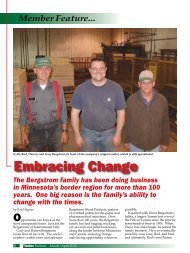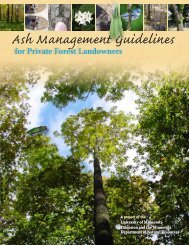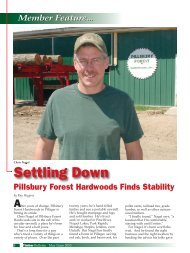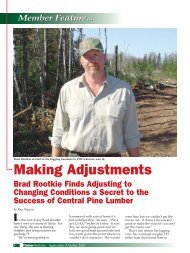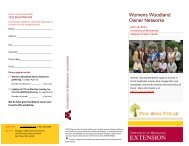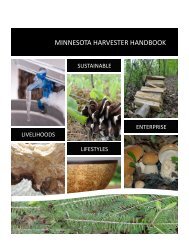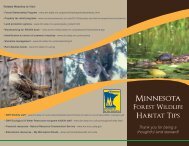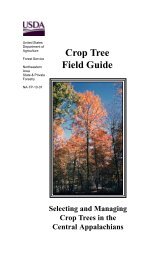Ash Management Guide for Private Forest Landowners
Ash Management Guide for Private Forest Landowners
Ash Management Guide for Private Forest Landowners
You also want an ePaper? Increase the reach of your titles
YUMPU automatically turns print PDFs into web optimized ePapers that Google loves.
Chapter 5The Native PlantCommunities<strong>Forest</strong>ed RichPeatland System<strong>Ash</strong> in the <strong>Forest</strong>edRich Peatland SystemThe range(purple) of<strong>Forest</strong>ed RichPeatlands inMinnesota andthose that includeash (dots).<strong>Forest</strong>ed Rich Peatland (FP) <strong>for</strong>estsare dominated by conifers, tamarack,northern white cedar, black spruce,and balsam fir. They occur on organicsoils that are deep, actively <strong>for</strong>mingpeat. Sphagnum moss is the principlepeat-<strong>for</strong>ming plant, although the woodyremains of trees and shrubs contributesignificantly to peat volume. Peat <strong>for</strong>msbecause FP sites are continuously waterlogged.By comparison to the atmosphere,water offers very little of the oxygen thatis needed to decompose plant remains -thus the buildup of organic peat. Furthermore,Sphagnum moss depletes thegroundwater of its dissolved nutrients,leaving the site acidic and so poor thatthe site cannot sustain large populationsof decomposing microbes even thoughthere is a large supply of “food.” FP sitesare, in general, poor habitat <strong>for</strong> ash trees.Like many environments, ash seedlingsare fairly common, appearing in 31% ofall FP <strong>for</strong>ests. But, the chances of growinginto a tree are slim – just 4% of FP <strong>for</strong>estsactually have ash trees and, when present,they account <strong>for</strong> only 4% of the trees.Achieving tree status probably occurs onmicrosites where the peat is thin enoughSurvey Recommendations: <strong>Forest</strong>ed Rich PeatlandsThere will be minimal effect on <strong>Forest</strong>ed Rich Peatland Systems because coniferswill continue to dominate these stands. Harvest when ground is frozen ordry; however, ash is too small a component of the <strong>for</strong>ested rich peatland systemto manage <strong>for</strong> its replacement.Recommended replacement trees (as ranked by the experts):<strong>Forest</strong>ed Rich Peatland (north only): 10 out of 11 species• Black spruce• Tamarack• White cedar• Balsam fir• White spruce• American elm (DED resistant)• Paper birch• White pine• Quaking aspen• Red maple48



